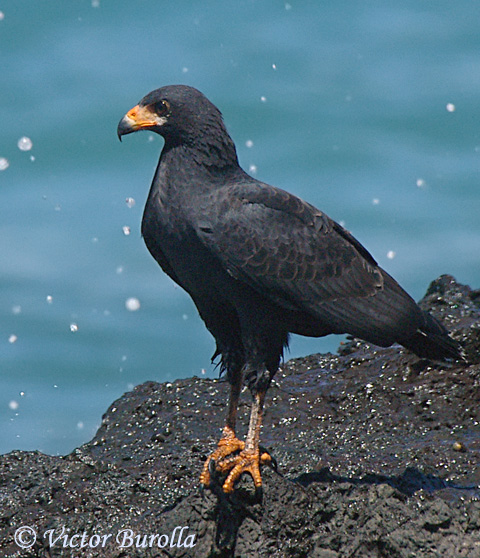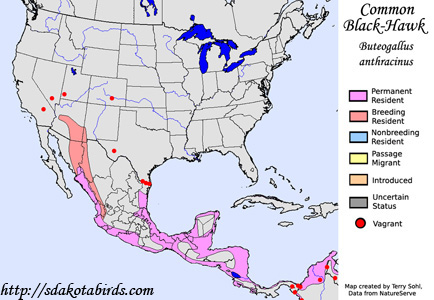| Length:20 inches | Wingspan: 48 inches | Seasonality: Non-resident in South Dakota |
| ID Keys: Black overall, long yellow or orange legs, very broad wings in flight, broad white band on tail | ||
 The
Common Black-Hawk is hawk of the tropical Americas that reaches the United
States in southern Arizona and New Mexico. They are just summer
breeding residents in the U.S., as birds in the U.S. portion of their range
move southward into Mexico and Central America for the winter.
Strongly associated with water, they are most often found on coastlines or
near inland water sources.
The
Common Black-Hawk is hawk of the tropical Americas that reaches the United
States in southern Arizona and New Mexico. They are just summer
breeding residents in the U.S., as birds in the U.S. portion of their range
move southward into Mexico and Central America for the winter.
Strongly associated with water, they are most often found on coastlines or
near inland water sources.
Habitat: In the U.S. portion of its range, Common Black-Hawks are almost always found near water sources, such as small streams and rivers with surrounding trees and riparian vegetation. In the tropical Americas, they can be found in a wider variety of habitats, but still have a preference for being near water sources.
Diet: Feeds on a variety of small animals, but tends to have a preference for animals found in and around water sources. Prey items may include fish, frogs, salamanders, lizards, small snakes, small birds, rodents and other small mammals, large insects, and crayfish and crustaceans. Crabs are a preferred food item in much of their tropical range, if available.
Behavior: Hunting is typically done by perching relatively low to the ground, looking for prey and swooping down to capture it when spotted. They will also sometimes walk along a shoreline or even in shallow water as they hunt. Less commonly, they can be seen in slow, low, gliding flights looking for food..
Nesting: The nest of a Common Black-Hawk is typically in a streamside tree in the United States, most often a tall sycamore or a cottonwood. The nest itself is a large platform of sticks, lined with green leaves and twigs. Both parents help to build the nest, incubate the eggs, and raise the young.
Song: Series of high crisp screamed notes, initially increasing in intensity, and then trailing off.
Migration: Considered a permanent resident throughout most of its range, but it is only a summer breeding resident in the United States portion of its range..
Interactive eBird Map: Click here for access to an interactive eBird map of Common Black Hawk sightings
Similar Species: Similar to the Mangrove Black-Hawk (which may be a sub-species of the Common Black-Hawk), but in the U.S. portion of its range, most likely to be confused with the Zone-tailed Hawk, Short-tailed Hawk, or Broad-winged Hawk.
Conservation Status: There are currently no perceived major threats to Common Black-Hawk populations, and the IUCN cites it as a species of "Least Concern". They do seem to be a little more affected by human disturbance than some American hawk species, and will abandon nesting locations if human disturbance becomes common.
Further Information: 1) Cornell's Neotropical Birds - Common Black-Hawk
2) University of Michigan's Animal Diversity Web - Common Black-Hawk
3) University of Minnesota Raptor Center - Common Black-Hawk
Photo Information: Photo by Victor Burolla - February 18th, 2005 - Costa Rica - Photo licensed under Creative Commons Attribution Share-Alike 2.0 Generic License
| Click below for a higher-resolution map |
 |
| South Dakota Status: Non-resident in South Dakota |
Additional Common Black-Hawk Photos (coming soon!!)
